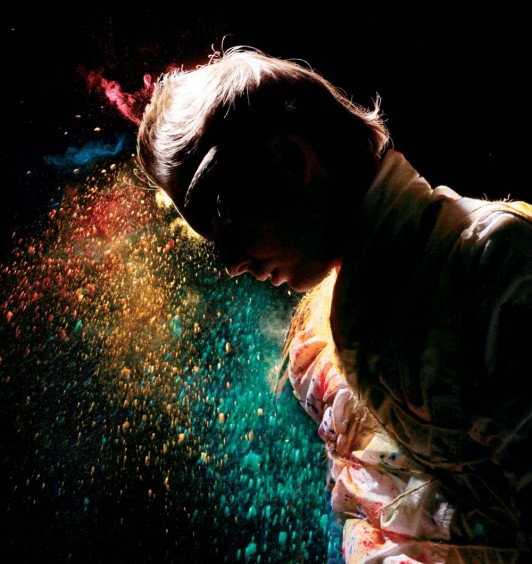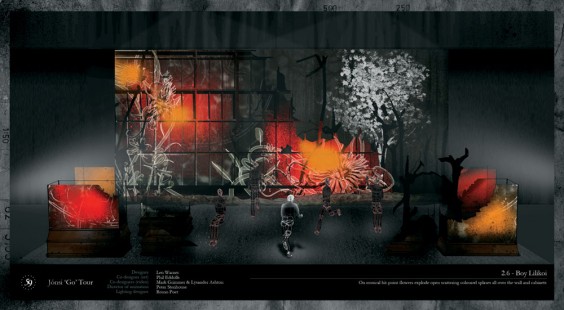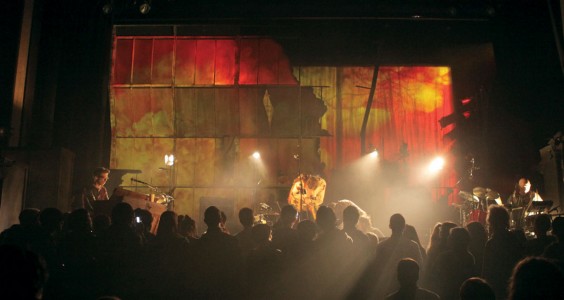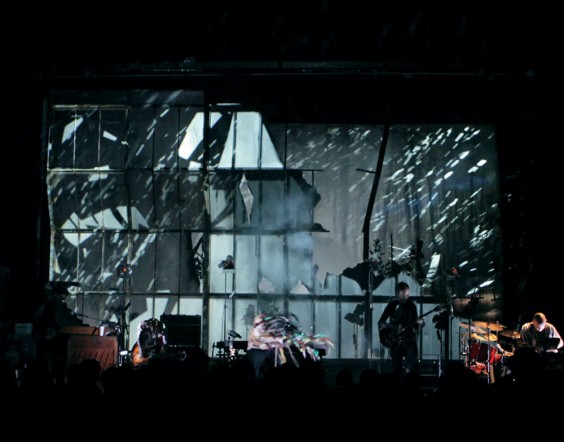This story first appeared in Chromatic: The Crossroads of Color and Music. Order your copy today.
Jónsi: “Animal Arithmetic”
[audio:https://alarm-magazine.com/wp-content/uploads/2011/09/jonsi_animalarithmetic.mp3|titles=Jónsi: “Animal Arithmetic”]
On February 1, 2008, one of Paris’ most cherished stores burnt to the ground. When the sun rose, it shed verdant light onto the gray, smoldering shell of an oddity-filled taxidermy shop called Deyrolle. Inside were hundreds of animals, among them a zebra whose stripes dissolved into a black, charred mass and a lion whose disfigured snout gave it a dark, Victorian-era mask. The tragic beauty of the scene caught the attention of a photographer named Martin d’Orgeval, who got permission to shoot the now half-burnt curiosities that had awed generations of Parisians since the mid-1800s.
D’Orgeval published his photos in a book called Touché par le Feu (Touched by Fire), which was purchased as a Christmas present the following year for one Leo Warner, the director of a group called Fifty Nine Productions, which was rapidly altering the landscape of theatre and opera with its video and set-design work. Now the company was working on a new type of project — a music tour.
The Fifty Nine team — which includes directors Mark Grimmer and Lysander Ashton — had been approached by Sigur Rós front-man Jón Þór Birgisson, better known as Jónsi, about designing the upcoming tour for his debut album, Go. “You can only imagine what it was like to get a call from Sigur Rós’ management, saying, ‘Jónsi from Sigur Rós wants to talk to you about doing a show,’” Grimmer says. “That was one of those pinch-yourself kind of moments.”
The Deyrolle photos, which captured a number of elements on Jónsi’s record, became the inspiration for the design. “Jónsi knew that animals were going to be involved from the very beginning,” Grimmer says. “Although we knew that we wanted the aesthetic of that taxidermy shop and this slightly strange, mysterious, burnt-out look…it needed to go from that decay and darkness into light.”
Concerning this light/dark dynamic, Jónsi comments, “A lot of stuff on the record is either about achieving great things through force of belief or the inverse of not getting anywhere because you let doubt into your heart. The colour, lack of colour, and images of growth represent these concepts.”
The role of color was crucial. Grimmer can’t say where exactly color first comes in, but it’s designed in such a way that there’s no colored lighting at the start. “We knew that we wanted to make an arc to the show, so that it starts out in quite a dark, mysterious, gothic place and ends in this triumphant celebration,” he says. Jónsi structured his set to match this narrative arc, putting the churning “Tornado” toward the beginning and ending with “Grow Till Tall,” a piece that builds slowly into an epic, exultant refrain.
Though visual images and music have been paired together since the advent of both, the work that Fifty Nine did for Jónsi is unique in that the lighting styles, narrative animation, and set design all are synced up to reinforce a single aesthetic. “Jónsi has this cinematic quality to his music,” Grimmer says, “and his imagination lends itself so well to a show like the one we did for him.”
The production team had agreed to the project. Inspiration had been handed to them in a book. They had the basic arc of the show. Now to create what they saw in their heads. They decided early on to use intelligent glass — milky white panes that become transparent when an electric current is added. “It’s a liquid crystal polymer,” Grimmer explains of the glass in the roughly six-foot-tall boxes scattered throughout the set design. “We were able to turn them transparent and light through them but also have them opaque and project onto them when we needed to.”
As ideas were born, they sometimes fell quickly to the cutting floor because Jónsi had only begun writing the album when Fifty Nine began designing. Though incredibly valuable from one point (“It’s really, really great to be involved at a very early stage,” Grimmer says), it also forced the team to adapt to the rapidly evolving record.
“The first recordings we listened to…in Reykjavik were acoustic-guitar tracks,” Grimmer says. “They were early demos, and it wasn’t really until [Jónsi] started making the arrangements with Nico Muhly…that it turned into the pop record that it became. So we had to keep up with that; our ideas developed alongside the music. We kept getting sent new versions of the tracks, and they were getting more and more complex.”
Fifty Nine’s ideas were growing more complex as well: the projection of an animated storyline would be fully integrated with the musical set, creating what the team saw as a visual score for Jónsi’s music. Though the band needed some flexibility and freedom, moments where two things — musically and visually — happened at precisely the same time were crucial to the experience. Devising ways to sync everything up was a challenge; the team commissioned a full orchestral score of the set so that, on tour, a video operator can follow it bar by bar. For certain pieces, drummer þorvaldur þorvaldsson cues video elements with a drum pad. The show inevitably needed a great deal of rehearsal time.
“In Sigur Rós, we scarcely rehearse at all — two days before a tour, maximum,” Jónsi says. “And even then, we are probably done halfway through the second day. This time, we rehearsed for a full week, and the production had been plotted and worked out for a week before that.”
“Taking what we were doing out of the equation all together,” Grimmer says, “this was still a really big deal for [Jónsi]. It was his first solo tour, and…all of a sudden this is new material people haven’t heard before, and he’s singing in English quite a lot of the time, and it has a very different feel than Sigur Rós. It was a lot of firsts for him.”
In fact, it was a year of firsts for everybody. It was also a year of minor catastrophes. “The whole year was full of ‘oh, shit’ moments, from beginning to end,” Grimmer adds. “You kind of just come to a point where you accept that that’s the way it’s going to be.” Even Jónsi’s costume requires constant attention; he sends it regularly back to Iceland for repairs.
The tour, which would stretch from April of 2010 almost to Christmas, traversing North America, Europe, Australia, Japan, and back again to Europe and North America for a second round of dates, was also unique in that Jónsi’s band included collaborator and partner Alex Somers on guitar and keyboard. “Alex is great,” Jónsi says. “He’s so hardcore and fastidious about everything that most things become honed to a peak of perfection.”
The need for perfection reached fever pitch just before the opening date in Vancouver. Grimmer, having worked 18-hour days until then alongside his team, recalled knowing that it was out of their hands: “The set was shipped to Canada…and we hoped it would all be all right when it arrived.”
Opening night at the Vogue Theatre was the zenith of the project’s own narrative arc. The lights dimmed over the ashen shell of the set, and the band began its sprawling, musical story. The response was visceral and has been so after almost every show — concertgoers have repeatedly posted their responses online, almost all of them paeans to the show’s emotional and visual power. Jónsi loves when that gets translated back to the band during the show. “The best moments have been when you feel a real, tangible energy coming back at you off the room,” he says. “That doesn’t happen every night, but when it does, it can truly drive you to new heights.”
The people at Fifty Nine Productions didn’t expect the crowd’s response that first night. “It got to the point where the focus was so much on just making things work technically, that I think we kind of lost sight of the fact that this was a show and there was going to be an audience there,” Grimmer says. “We were all quite overwhelmed at the reaction, because we’d forgotten about that human element. We all really needed that. It meant it was ready to go.”






